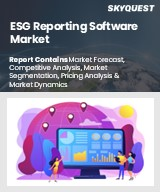
세계의 ESG 리포팅 소프트웨어 시장 규모는 2023년에 11억 달러로 평가되며, 2024년 13억 달러에서 2032년에는 48억 8,000만 달러로 성장하며, 예측 기간(2025-2032년)의 CAGR은 18.0%로 성장할 전망입니다.
세계 ESG 보고 소프트웨어 시장은 견고한 성장세를 보이고 있으며, 그 주요 요인은 다양한 지역에서 환경, 사회, 지배구조(ESG) 규제가 엄격하게 시행되고 있기 때문입니다. 정부, 규제 당국, 금융기관은 투명한 보고 기준을 요구하고 있으며, 기업은 GRI(Global Reporting Initiative)나 TCFD(Climate-related Financial Disclosure Task Force)와 같은 프레임워크를 준수해야 합니다. 컴플라이언스 위반은 재무적 리스크와 평판 리스크를 초래하므로 기업은 효율적인 데이터 관리와 보고 자동화를 위해 ESG 보고 전문 툴에 투자하고 있습니다. 또한 투자자, 소비자, 이해관계자들의 투명성에 대한 요구가 높아짐에 따라 기업은 지속가능성 성과와 윤리적 관행을 공개해야 하는 상황에 직면해 있으며, ESG 보고 소프트웨어를 활용함으로써 기업은 데이터의 정확성을 높이고, 이해관계자들의 신뢰를 쌓고, 장기적인 가치를 확보할 수 있으며, 시장의 보급을 더욱 촉진할 수 있습니다.
Global ESG Reporting Software Market size was valued at USD 1.1 billion in 2023 and is poised to grow from USD 1.3 billion in 2024 to USD 4.88 billion by 2032, growing at a CAGR of 18.0% during the forecast period (2025-2032).
The global ESG reporting software market is experiencing robust growth, primarily fueled by the implementation of strict environmental, social, and governance (ESG) regulations across various regions. Governments, regulators, and financial institutions are enforcing transparent reporting standards, compelling companies to conform to frameworks like the Global Reporting Initiative (GRI) and the Task Force on Climate-related Financial Disclosures (TCFD). Non-compliance poses financial and reputational risks, prompting organizations to invest in specialized ESG reporting tools for efficient data management and reporting automation. Furthermore, increasing demands for transparency from investors, consumers, and stakeholders amplify this trend, as companies are pressured to disclose their sustainability performance and ethical practices. By leveraging ESG reporting software, organizations can enhance data accuracy, build stakeholder trust, and secure long-term value, further driving market adoption.
Top-down and bottom-up approaches were used to estimate and validate the size of the Global ESG Reporting Software market and to estimate the size of various other dependent submarkets. The research methodology used to estimate the market size includes the following details: The key players in the market were identified through secondary research, and their market shares in the respective regions were determined through primary and secondary research. This entire procedure includes the study of the annual and financial reports of the top market players and extensive interviews for key insights from industry leaders such as CEOs, VPs, directors, and marketing executives. All percentage shares split, and breakdowns were determined using secondary sources and verified through Primary sources. All possible parameters that affect the markets covered in this research study have been accounted for, viewed in extensive detail, verified through primary research, and analyzed to get the final quantitative and qualitative data.
Global ESG Reporting Software Market Segments Analysis
Global ESG Reporting Software Market is segmented by Component, Deployment Mode, Organization Size, End User and region. Based on Component, the market is segmented into Software and Services. Based on Deployment Mode, the market is segmented into Cloud-Based and On-Premises. Based on Organization Size, the market is segmented into Large Enterprises and Small and Medium Enterprises (SMEs). Based on End User, the market is segmented into Banking, Financial Services, and Insurance (BFSI), Government, Public Sector & Non-Profit, Manufacturing, Healthcare & Life Sciences, Retail & Consumer Goods and Energy & Utilities. Based on region, the market is segmented into North America, Europe, Asia Pacific, Latin America and Middle East & Africa.
Driver of the Global ESG Reporting Software Market
The lack of universally accepted ESG reporting standards poses a significant obstacle for organizations aiming to implement ESG reporting software. In the absence of standardized frameworks, companies often find it difficult to synchronize their reporting processes, resulting in confusion and operational inefficiencies. This inconsistency not only complicates the adoption of such software but also restricts overall market expansion. As businesses grapple with the challenge of varying requirements and expectations, the growth of the global ESG reporting software market may be stunted, underscoring the need for a cohesive and widely recognized set of standards to drive progress and facilitate smoother implementation.
Restraints in the Global ESG Reporting Software Market
The Global ESG Reporting Software market faces significant constraints due to the lack of universally accepted ESG reporting standards. This absence of standardized frameworks creates hurdles for companies striving to implement ESG reporting software effectively. As a result, organizations may find it challenging to synchronize their reporting processes, causing confusion and inefficiencies in their operations. This inconsistency not only complicates the reporting landscape but also inhibits the widespread adoption of ESG software solutions, ultimately stalling market expansion and limiting the potential for companies to fully leverage the benefits of effective ESG reporting practices.
Market Trends of the Global ESG Reporting Software Market
The Global ESG Reporting Software market is experiencing a significant trend towards the incorporation of AI-driven automation, which is revolutionizing the accuracy and efficiency of ESG reporting. By leveraging advanced machine learning algorithms and real-time data analysis, firms can now detect anomalies and gain predictive insights that enhance their compliance with regulatory standards and fulfill stakeholder expectations. This technology not only streamlines the reporting process, reducing the reliance on manual efforts, but also fosters greater transparency in corporate sustainability practices. As organizations increasingly prioritize responsible governance, the demand for sophisticated ESG reporting software solutions is poised for robust growth.